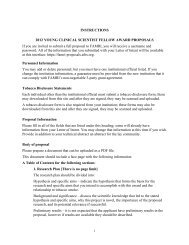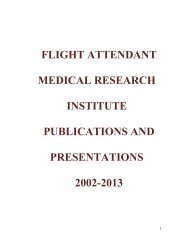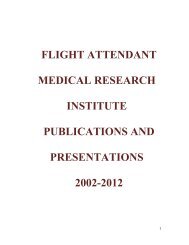MISSION
2009 compendium of FAMRI-supported research - Flight Attendant ...
2009 compendium of FAMRI-supported research - Flight Attendant ...
You also want an ePaper? Increase the reach of your titles
YUMPU automatically turns print PDFs into web optimized ePapers that Google loves.
Estrogen activates the cell cycle by triggering p27 degradation. Prior work showed that p27 is required for<br />
therapeutic efficacy of tamoxifen. Dr. Slingerland recently demonstrated that Src binds and phosphorylates<br />
p27, promoting p27 destruction. The Src signaling kinase binds epidermal growth factor receptor (EGFR)<br />
family members to synergistically stimulate cell proliferation, motility, and survival. Src and EGFR/Her2<br />
family members are over-expressed in up to 70% of primary human breast cancers. Src is also activated by<br />
estrogen. When estrogen binds the ER, it recruits and activates Src signaling to promote mitogenesis.<br />
Overexpression of Her2 and Src in ER positive breast cancer cells alters p27 phosphorylation, impairs<br />
p27’s cdk inhibitor action, and causes antiestrogen resistance. The hypothesis is that Src promotes p27<br />
degradation and loss of function, leading to antiestrogen resistance. ER positive breast cancers with high<br />
Src activity may show reduced p27 protein and be resistant to antiestrogen therapy. In the last year, Dr.<br />
Slingerland obtained xenograft data showing that the Src inhibitor, AZD0530, acts synergistically with<br />
anastrozole to inhibit the growth of ER positive breast cancer xenograft tumors in vivo, and thus may prevent<br />
or delay resistance to antiestrogens. Moreover, the Src inhibitor caused a greater increase in p27 levels<br />
and a greater reduction in the proliferation marker Ki67 in these xenograft tumors than either drug when<br />
given alone. Thus, restoration of p27 function restores the efficacy of analstrozole to impair breast cancer<br />
cell proliferation. Another goal was to further investigate how Src mediated phosphorylation influences<br />
cyclin-Cdk action. Current data indicate that Src-mediated tyrosine phosphorylation of p27 bound to<br />
cyclin D-Cdk complexes are essential for catalytic activation of these complexes. Further work is underway<br />
to determine how PI3K effectors and Src influence the assembly of p27-cyclin-Cdk complexes, their<br />
nuclear import, and their activation. Xenograft experiments are underway to test if AZD0530 and ER<br />
blockade by selective ER modulators, such as faslodex and IOS5974, can delay or prevent resistance to<br />
faslodex in ER positive breast cancer xenografts. The data may support clinical trials of Src inhibitors to<br />
prevent or delay the development of antiestrogen resistance in ER positive breast cancer and expedite the<br />
clinical implementation of Src inhibitors in breast cancer therapy.<br />
ROLE OF SECOND TOBACCO HAND SMOKE IN BREAST CANCER ANGIOGENESIS AND METASTASIS<br />
Shalom Avraham, MD, PhD; Harvard University; CIA 2007<br />
SHS is classified as a known human carcinogen which causes atherosclerosis and cancer. Recent studies<br />
have strongly suggested that breast cancer has a nexus with passive and active smoking. Dr. Avraham examined<br />
the effect of nicotine exposure on breast cancer cell proliferation, survival, and apoptosis. The results<br />
show that breast cancer cells exposed to nicotine had decreased extracellular signal-regulated kinase (ERK)<br />
activation and enhanced activation of protein kinase B (AKT). Nicotine had no effects on vascular<br />
endothelial growth factor (VEGF) secretion from breast cancer cells but it enhanced the transmigration of<br />
breast cancer cells. As a result, nicotine increases the cell survival of breast cancer cells through the activation<br />
of the phosphatidyl-inositol-3-kinase (PI3K)-AKT pathway and acts as a chemotaxis agent to induce<br />
invasion and migration of breast cancer cells. Further, nicotine induced changes in genes are indicative for<br />
the process of epithelial to mesenchymal transition (EMT), as characterized by decrease in E-cadherin and<br />
ZO-1 expression. Thus, nicotine is able to induce invasion and EMT of breast cancer cells, contributing to<br />
breast cancer progression.<br />
HOW SECOND-HAND TOBACCO SMOKE AFFECTS BREAST TUMOR DORMANCY IN THE LUNG<br />
Stuart S. Martin, PhD; University of Maryland; CIA 2007<br />
Nearly 90% of all human solid tumors arise from a class of cells known as epithelial cells. When these<br />
tumor cells begin to spread through the bloodstream, they cannot easily fit through capillaries due to their<br />
large size, thus often becoming trapped in the first capillary bed they encounter, which is generally in the<br />
lung. A further understanding of how circulating tumor cells invade the lung could improve the understanding<br />
of the risks posed by exposure to SHS. In recent publications, Dr. Martin has noted that circulating<br />
tumor cells generate novel extensions, that he has named microtentacles. These microtentacles are supported<br />
by a unique coordination of microtubules and vimentin intermediate filaments. Importantly, these<br />
microtentacles are restrained by polymerized actin that provides a barrier at the cell surface. Cigarette<br />
smoke has been shown to disrupt polymerized actin and could therefore increase microtentacles. As recommended<br />
by FAMRI grantee Dr. Jeff Wolf, Dr. Martin obtained cigarette smoke condensate and tested<br />
its effects on breast tumor cells. In the weakly aggressive Zr-75-1 cell line, which has low levels of microtentacles,<br />
cigarette smoke condensate significantly increased microtentacles. These results pose the question<br />
of whether exposure to cigarette smoke can increase the aggressive actions of circulating breast tumor cells.<br />
Since the lung is such an important site of primary metastasis, the question of how SHS affects circulating<br />
tumor cells is particularly relevant. It is now possible to use light emission from firefly luciferase to track<br />
7 4 P A G E







